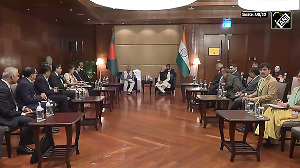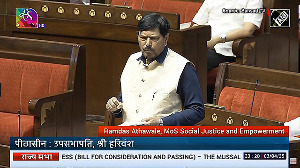On my social networking accounts, the updates from Indian friends, media types, and cultural elites still focus almost exclusively on US President Barack Obama's recent visit to India. Some praise him. Some condemn him. Some post a funny portrait of him morphing into Lalu Prasad Yadav.
Likewise, the homepages of Indian online news sites remain awash with images of the First Couple dancing to Marathi music, of Barack and Manmohan sharing a warm embrace, of Michelle's fabulous fashion choices, of Mumbaikars on tip-toes waiting for Mr Hope and Change himself.
The point is, Obama is dominating Indian cyber space. In the traditional Indian media, it's much the same.
The 24-hour television media tamasha marches on. And newspapers in every Indian language offer an endless stream of opinion pieces, from fiery and bald-faced condemnation of all-things to Obama to starry-eyed and wistful lamentations that India doesn't produce such charismatic leaders.
 Finally, out on the streets, everyone is still talking about him, too.
Finally, out on the streets, everyone is still talking about him, too.
In short, if you live in India, it is utterly impossible to be unaware that US President Barack Obama was recently in Mumbai and Delhi.
Meanwhile, on the US side of things, there's near silence. From my American friends, nary a post about the trip, except a few hysterical comments on the absurd story that Obama's India voyage could cost US taxpayers $ 200 million per day. (It's interesting that only the flagrantly false and sensational was able to drum up interest in the more politically vocal of my American Internet friends -- a statement about the role of the Internet in news consumption, perhaps?)
Of course, there were real stories, too. For a few days, 'Obama in India' was front-page news in major national dailies like The New York Times, The Washington Post, and USA Today. Pulitzer Prize-winning journalist Jim Yardley of The New York Times wrote a few in-depth articles, as did The Washington Post's Emily Wax. Popular political news aggregator RealClearPolitics.com collected at least a dozen editorials, including one from The Wall Street Journal, which praised Obama's speech to the Indian Parliament as perhaps the best of his presidency.
However, most of the scant US-generated commentary expressed slight skepticism, unimpressed with the visit's modest agenda, and basically asked, 'So, what's the point?'
By Tuesday, the US media had moved on to 'Obama and Indonesia' and 'Bush and his Memoirs'. In fact, yesterday a search on the home page of USA Today revealed just two hits for 'India', both related to sports teams from the US state of Indiana. Even the release of a much-anticipated video game has overtaken 'Obama in India'.
Sure, it could be said that, with the US media still digesting the Republican Party's victory in the November 2 mid-term elections, and given the lack of a 'big-ticket' issue to define the trip, 'Obama in India' didn't grab as many headlines as it might have under different circumstances.
But there's a deeper, more fundamental issue at play: most Americans still don't know much about India, and don't really care to.
India -- despite being a democracy, despite housing nearly 20% of humanity, despite producing one of America's impressive immigrant groups, despite being a natural ally for America in one of the world's most hostile regions hardly registers as more than a blip on the mainstream US cultural radar.
Far too many American still equate India with Apu the convenience store owner from The Simpsons, with nerdy and robotic doctors and science professionals, with Slumdog Millionaire and Bollywood, and with outsourcing and job loss.
Most Americans don't know of Manmohan Singh or Sonia Gandhi or LK Advani, or the Congress Party or the Bharatiya Janata Party or the Left Front. In fact, most don't know of any Indian political figure, save Mahatma Gandhi, or perhaps Nehru and Indira Gandhi if they're particularly well-educated.
And while this is an indictment of the US education system and general media in its portrayal of India, it also illustrates an important point: India finds itself facing some serious PR work in America.
What could improve this?
In all likelihood, Kashmir and Pakistan issues will continue to consume domestic and international politics in New Delhi. Likewise, as long as Washington DC relies on Islamabad to execute its War on Terror, India will not receive the explicit condemnation of Pakistani-linked terrorism it desires and deserves. In a sense, the hands of both governments are tied, and might remain so for quite some time.
Rather than relying on these official state visits, which inevitably get used in both countries as bickering points in partisan squabbles, perhaps it's time for more real person-to-person contact.
India is known to many in America as a difficult place to visit, for both business and pleasure.
Perhaps the perception of India could be improved through better tourism campaigns and more manageable visa laws? Perhaps more direct foreign investment from American corporations might encourage stronger ties in business and industry and promote bilateral and mutually beneficent trade?
One thing's certain: As India's economy continues its robust growth and the country matures, more and more Americans will want to be here. And their experiences will go a long way towards moving India into the mainstream, more so than any presidential visit.








 © 2025
© 2025